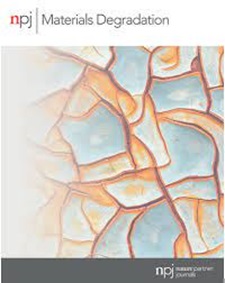电化学阻抗谱中腐蚀分析常用等效电路模型的贝叶斯评估
IF 7.6
2区 材料科学
Q1 MATERIALS SCIENCE, MULTIDISCIPLINARY
引用次数: 0
摘要
电化学阻抗谱(EIS)是评价金属材料腐蚀的一项重要技术。EIS的分析取决于选择合适的等效电路模型(ECM)来准确表征所研究的系统。在这项工作中,我们系统地检查了三种常用ecm在几种典型材料降解场景中的适用性。通过将贝叶斯推理应用于模拟腐蚀EIS数据,我们评估了这些ECM在不同腐蚀条件下的适用性,并确定了EIS数据缺乏足够信息来统计证实ECM结构的区域。此外,我们假设传统的EIS分析方法通常需要测量非常低的频率,对于正确建模适当的ECM可能并不总是必要的。我们的研究评估了从低频到中频范围忽略数据对推理结果的影响,并揭示了低频测量的很大一部分可以被排除,而不会大大损害提取系统参数的准确性。此外,我们提出了对ECM成分的后验分布和后验预测的简单检查,可用于定量评估特定ECM的适用性和需要测量的最小频率。该框架指出了通过智能减少低频数据收集和允许实时EIS测量来加快EIS采集的途径。本文章由计算机程序翻译,如有差异,请以英文原文为准。

Bayesian assessment of commonly used equivalent circuit models for corrosion analysis in electrochemical impedance spectroscopy
Electrochemical Impedance Spectroscopy (EIS) is a crucial technique for assessing corrosion of metallic materials. The analysis of EIS hinges on the selection of an appropriate equivalent circuit model (ECM) that accurately characterizes the system under study. In this work, we systematically examined the applicability of three commonly used ECMs across several typical material degradation scenarios. By applying Bayesian Inference to simulated corrosion EIS data, we assessed the suitability of these ECMs under different corrosion conditions and identified regions where the EIS data lacks sufficient information to statistically substantiate the ECM structure. Additionally, we posit that the traditional approach to EIS analysis, which often requires measurements to very low frequencies, might not be always necessary to correctly model the appropriate ECM. Our study assesses the impact of omitting data from low to medium-frequency ranges on inference results and reveals that a significant portion of low-frequency measurements can be excluded without substantially compromising the accuracy of extracting system parameters. Further, we propose simple checks to the posterior distributions of the ECM components and posterior predictions, which can be used to quantitatively evaluate the suitability of a particular ECM and the minimum frequency required to be measured. This framework points to a pathway for expediting EIS acquisition by intelligently reducing low-frequency data collection and permitting on-the-fly EIS measurements.
求助全文
通过发布文献求助,成功后即可免费获取论文全文。
去求助
来源期刊

npj Materials Degradation
MATERIALS SCIENCE, MULTIDISCIPLINARY-
CiteScore
7.80
自引率
7.80%
发文量
86
审稿时长
6 weeks
期刊介绍:
npj Materials Degradation considers basic and applied research that explores all aspects of the degradation of metallic and non-metallic materials. The journal broadly defines ‘materials degradation’ as a reduction in the ability of a material to perform its task in-service as a result of environmental exposure.
The journal covers a broad range of topics including but not limited to:
-Degradation of metals, glasses, minerals, polymers, ceramics, cements and composites in natural and engineered environments, as a result of various stimuli
-Computational and experimental studies of degradation mechanisms and kinetics
-Characterization of degradation by traditional and emerging techniques
-New approaches and technologies for enhancing resistance to degradation
-Inspection and monitoring techniques for materials in-service, such as sensing technologies
 求助内容:
求助内容: 应助结果提醒方式:
应助结果提醒方式:


